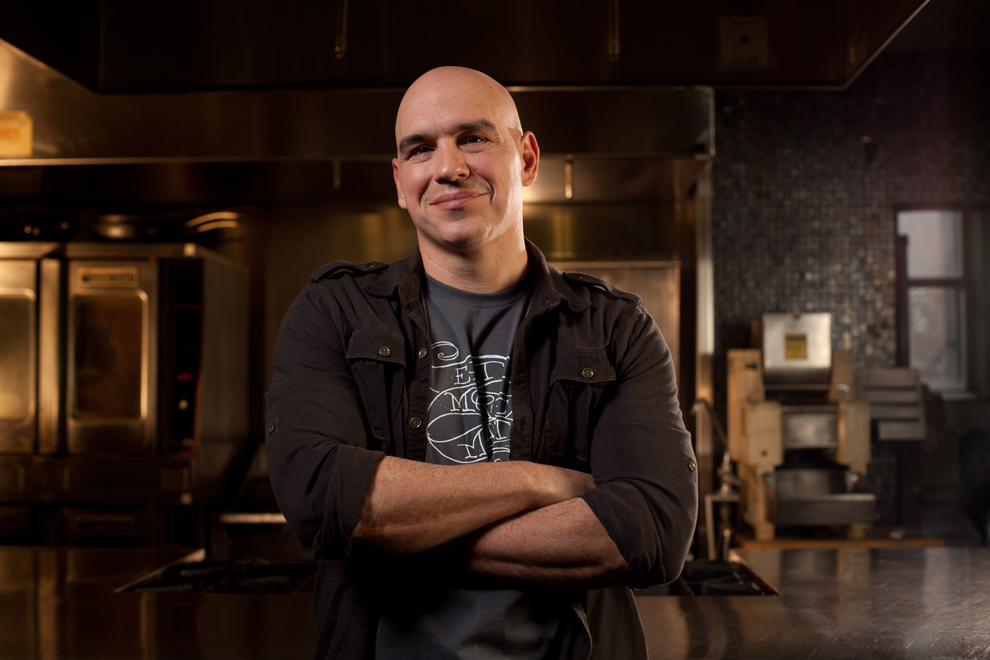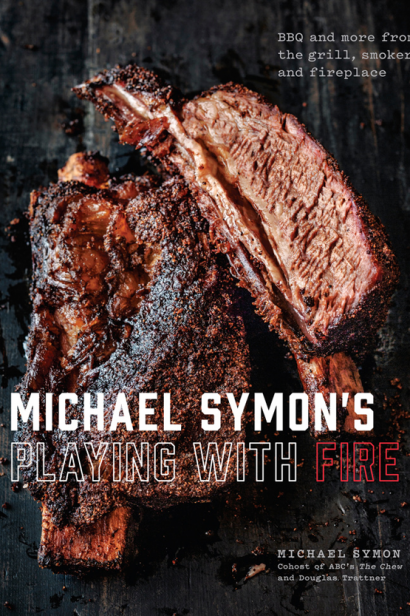The Flavors of Fire
Memories of his mom’s well-loved braised beef with tomato sauce, his fondness for the constant lasagna he grew up with and how he grills Swiss chard for his wife, Liz, who is a vegetarian, to give a sense of char to an otherwise green vegetable, are what make my time with Chef Michael Symon so soulful and noteworthy. Symon is a James Beard Award–winning chef known for his 18+ restaurants, his roles on “Iron Chef” and “The Chew” and more. We had a chance to catch him at his book signing in Columbus and talk about how his new cookbook, Playing with Fire: BBQ and More from the Grill, Smoker, and Fireplace, co-written with Douglas Trattner, highlights the culture of barbecue in America. Read on about live-fire cooking through Symon’s eyes. —Colleen Leonardi
Why is sense of place so important to good barbecue?
I think sense of place is important to cooking in general. People cook things that are around them. With barbecue, for instance, in the Carolinas alone there are four different kinds of barbecue styles. Most of it is whole hog, but one place uses a straight vinegar sauce, one place uses a vinegar sweet sauce, one place uses a mustard sauce. It depends if you’re in the eastern part or northern part—it changes that much in one region. Texas barbecue is very different from Kansas City. Kansas City barbecue is sweeter and tomato based. In the Carolinas it tends to be a little bit more vinegar-based. In Texas there is no sauce at all. It all changes by region based on the foods that are near them and the palate of that region, so to speak.
Barbecue is a technique, not a sauce. It’s a method of cooking. I think people in regions of America that don’t have a barbecue culture think of barbecue as a sauce. They’re, like, “I’m making barbecue chicken,” and they put it on a gas grill and they put barbecue sauce on it, and they think they made barbecue chicken. Barbecue chicken in barbecue cultures would be: You go outside, you set up your smoker, you fire it up, you smoke the chicken over a slower temperature to infiltrate that flavor and it may have no barbecue sauce at all.
It was important to us when we opened Mabel’s in Cleveland that we didn’t try to mimic another culture’s style of barbecue. We tried to develop a style of barbecue that we thought would be regionally specific to what we grew up with. Local fruit woods, a sauce with brown mustard because that’s the mustard of choice in Cleveland. (I always kid I didn’t want to do a ketchup-based sauce because that’s from Pittsburgh—Heinz comes from Pittsburgh.)
You know, the food in France is different from the food in Italy is different from the food in Germany. Barbecue is like that throughout the United States, and it really is the only style of cuisine that is truly American. We wanted to really make sure that we represented the regions properly.
I think it’s helping to educate people more and more that barbecue is a culture.
It is a culture. You know, you go to Kentucky and say barbecue and it’s mutton on the smoker with this molasses-y kind of base. So it just depends where you are. And food should identify where you are.
I’m curious how your Greek and Sicilian heritage influences your approach to live-fire cooking.
We’re essentially Greek, Sicilian and Eastern European, but I do think the Eastern European side influences it more. If you look at Eastern European culture, the smoking of bacon and kielbasa and sausages and hams—that all comes from Eastern Europe.
So I think that very much has influenced the way I cook and think of live fire. Italy doesn’t use a ton of live-fire cooking. Greece uses a lot but predominately with seafood and usually over coals, not wood.
I think it’s influenced how I feel about food. Growing up in Cleveland, I’d say 80% of the meals cooked for us growing up were either Greek or Italian food. When our mom went away from Greek or Italian food, like when she tried to make something very Americana, it wasn’t as good.
I recently read a great article in Saveur magazine about barbecue on the South Side of Chicago and how cooking techniques might not make it to the next generation. What is the future of live-fire cooking, in your opinion, and do you think any of the styles you discovered while conducting your research for Playing with Fire might get lost with this next generation?
I think the culture is having a little bit of a moment, which will definitely help it. It might water it down. Sometimes when styles of cooking have a moment it waters it down a little bit, which I would hate. For instance Rodney Scott, who I feature in the book, who is based in Charleston now. He’s third generation. He’s been cooking whole hog since he’s been 13 years old. He used to man the pits at his dad’s barbecue place by the time he was 17. Now he’s 48 years old. So that’s a perfect example of a tradition that is really continuing.
It used to be, I think, back then where you could do whole hog, like his dad’s place did whole hog. You pulled out the whole hog, the whole hog got chopped, people came and ate the whole hog, they got some sides, and they went home. That was it.
Now customers, because of the chain restaurants, they’re, like, “What do you mean I can only get whole hog?” So it’s pressured even someone like Rodney to do a smoked rib eye sandwich. What he’s doing is whole hog. But even he said, when he opened his barbecue place in Charleston he built 10 giant pits so he could do 10 whole hogs at a time, and the first day they were open 90% of their sales were ribs. Ribs aren’t what made his family famous, but ribs are what people want.
So you have to adjust a little bit. It’s different now. I still think the traditions will be there but they’ll get watered down a bit because of the consumer.
It’s almost summer, and as a Clevelander what local produce and seasonal foods are you most excited about cooking with this season?
I keep a big garden, so I love when tomatoes, or the variety of heirloom tomatoes, and sweet corn arrive. They’re always a favorite. We’re ending the ramp season now, which I love, and the morels, which are more spring.
I always feel that the closer you can get to the source the better off you are. Local strawberries, I love, both in sweet and savory cooking. One of the herbs that I’m in love with now is cutting celery—lovage—which has become a big part of my cooking, which I really love, and in the summer at my house it grows like a bush, which is great.
Once summer starts I kind of fire up the grill and the smoker and I never really go back in the house. I keep everything pretty simple. The fire is like another seasoning.
Find great recipes by Symon and learn more about his restaurants here and order your copy of Symon’s new cookbook Playing with Fire here.






